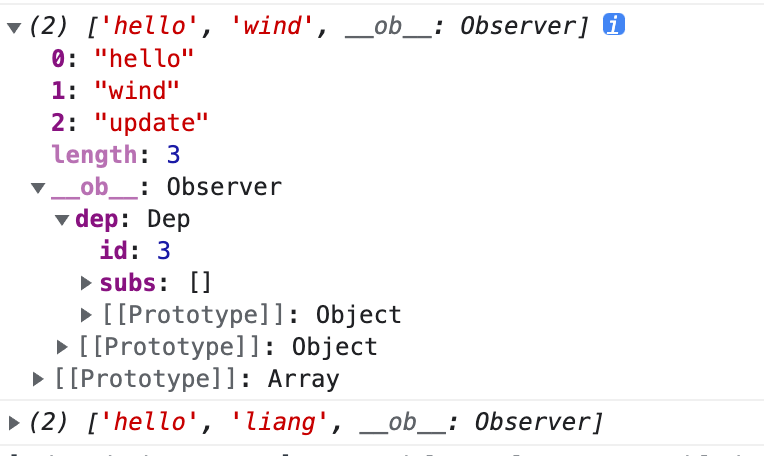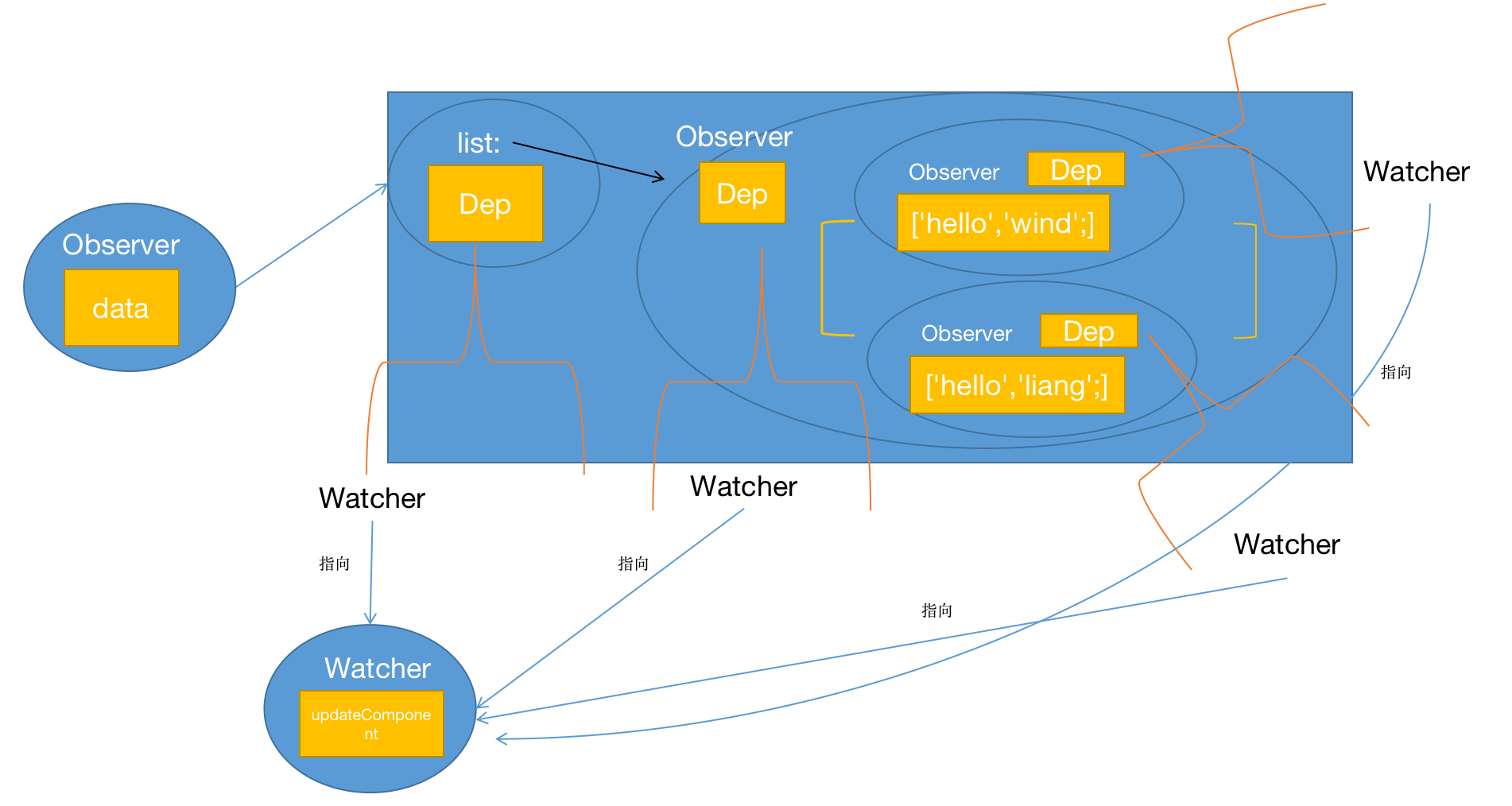接 Vue2剥丝抽茧-响应式系统 (opens new window)、Vue2剥丝抽茧-响应式系统之分支切换 (opens new window),响应式系统之嵌套 (opens new window)、响应式系统之深度响应 (opens new window) 、Vue2剥丝抽茧-响应式系统之数组 (opens new window) 还没有看过的同学需要看一下。
# 场景1
import { observe } from "./reactive";
import Watcher from "./watcher";
const data = {
list: [
{
text: "hello",
},
],
};
observe(data);
const updateComponent = () => {
for (const item of data.list) {
console.log(item.text);
}
};
new Watcher(updateComponent);
data.list[0].text = "liang";
先思考 1 分钟,上边会输出什么。
... ...
是的,只会输出一次 hello,而 data.list[0].text = "liang"; 没有触发更新。
没有触发原因是因为我们并没有给 {text:'hello'} 变为响应式的。
代码中我们只处理了整个数组,并没有处理数组中的元素,因此需要补一个 for 循环来将数组中的对象也变为响应式的。
export class Observer {
constructor(value) {
this.dep = new Dep();
def(value, "__ob__", this);
if (Array.isArray(value)) {
if (hasProto) {
protoAugment(value, arrayMethods);
} else {
copyAugment(value, arrayMethods, arrayKeys);
}
/******新增 *************************/
this.observeArray(value);
/************************************/
} else {
this.walk(value);
}
}
/**
* 遍历对象所有的属性,调用 defineReactive
* 拦截对象属性的 get 和 set 方法
*/
walk(obj) {
const keys = Object.keys(obj);
for (let i = 0; i < keys.length; i++) {
defineReactive(obj, keys[i]);
}
}
/**
* Observe a list of Array items.
*/
/******新增 *************************/
observeArray(items) {
for (let i = 0, l = items.length; i < l; i++) {
observe(items[i]);
}
}
/************************************/
}
# 场景2
const data = {
list: [
["hello", "wind"],
["hello", "liang"],
],
};
observe(data);
const updateComponent = () => {
for (const item of data.list) {
console.log(item);
}
};
new Watcher(updateComponent);
data.list.push(["hello"]);
data.list[0].push("update");
先思考 1 分钟,上边会输出什么。
... ...
现在相当于一个二维数组,第一次运行输出下边的应该没什么疑问:

每一个数组对象都会有一个 __ob__ 对象指向自身的 Observer 。
Observer 对象中有一个 Dep 对象来收集依赖。

再具体的可以回顾下 Vue2剥丝抽茧-响应式系统之数组 (opens new window) 。
那么 data.list.push(["update"]); 会触发 Watcher 的执行吗?
会的,我们的 data.list 已经收集到依赖了。
那么接下来 data.list[0].push("update"); 会触发 Watcher 的执行吗?
并不会, 虽然 data.list[0] 这个数组里成功加入了 update ,但 data.list[0] 没有收集到依赖,所以并不会触发 Watcher 执行。
看一下依赖图:

list 是一个数组,包含 ["hello", "wind"] 和 ["hello", "liang"] ,通过上边场景 1 对数组中的元素进行了响应式处理,所以它们都包含在了 Observer 对象中,并且拥有了 Dep 对象。
但在 get 的时候我们只对 [["hello", "wind"],["hello", "liang"]] 这个整体进行了依赖的收集,它们中的数组元素并没有去收集依赖。
所以如果是数组的话,我们也需要循环数组中的元素,如果元素是数组需要手动进行依赖收集。
/**
* Define a reactive property on an Object.
*/
export function defineReactive(obj, key, val, shallow) {
const property = Object.getOwnPropertyDescriptor(obj, key);
// 读取用户可能自己定义了的 get、set
const getter = property && property.get;
const setter = property && property.set;
// val 没有传进来话进行手动赋值
if ((!getter || setter) && arguments.length === 2) {
val = obj[key];
}
const dep = new Dep(); // 持有一个 Dep 对象,用来保存所有依赖于该变量的 Watcher
let childOb = !shallow && observe(val);
Object.defineProperty(obj, key, {
enumerable: true,
configurable: true,
get: function reactiveGetter() {
const value = getter ? getter.call(obj) : val;
if (Dep.target) {
dep.depend();
if (childOb) {
if (Array.isArray(value)) {
childOb.dep.depend(); // [["hello", "wind"],["hello", "liang"]] 这个整体进行了依赖的收集
/******新增 *************************/
dependArray(value); // 循环数组中的元素,如果是数组的话进行依赖收集。
/************************************/
}
}
}
return value;
},
...
}
/**
* Collect dependencies on array elements when the array is touched, since
* we cannot intercept array element access like property getters.
*/
function dependArray(value) {
for (let e, i = 0, l = value.length; i < l; i++) {
e = value[i];
if (Array.isArray(e)) {
e && e.__ob__ && e.__ob__.dep.depend();
dependArray(e); // 递归进行
}
}
}
这样的话,数组中的数组也会收集到当前依赖了。

# 场景3
const data = {
list: [
["hello", "wind"],
["hello", "liang"],
],
};
observe(data);
const updateComponent = () => {
for (const item of data.list) {
console.log(item);
}
};
new Watcher(updateComponent);
data.list.push(["hi"]);
data.list[2].push(["liang");
如果我们给 data.list 新添加了一个数组,然后对这个新数组添加一个元素会触发 Watcher 执行吗?
可以先思考 1 分钟。
... ...
我们把 data.list 打印一下:

数组整体有一个 Obserever,list[0] 有一个 Obeserver,list[1] 有一个 Obeserver,但新加入的 list[2] 并没有 Observer,所以它不是响应式数据,对它进行操作并不会触发 Watcher 的执行。
原因在于我们拦截数组 push 操作的时候,对新添加的元素没有调用 observe 方法去把它变成响应式的,因此这里需要补一下。
/**
* Intercept mutating methods and emit events
*/
methodsToPatch.forEach(function (method) {
// cache original method
const original = arrayProto[method];
def(arrayMethods, method, function mutator(...args) {
const result = original.apply(this, args);
const ob = this.__ob__;
/******新增 *************************/
let inserted; // 加添加的元素拿到
switch (method) {
case "push":
case "unshift":
inserted = args;
break;
case "splice":
inserted = args.slice(2);
break;
}
if (inserted) ob.observeArray(inserted);
/************************************/
// notify change
ob.dep.notify();
return result;
});
});
其中 observeArray 就是我们场景 1 添加的函数。可以看到数组中新添加的元素也拥有了 Observer。

# 总
这篇文章主要解决了两个问题,
如果是数组,需要将数组中的元素进行响应式处理。此外对于新添加的元素也需要进行响应式处理。
收集依赖的时候,需要对数组中的数组进行依赖收集。
如果没有收集到依赖就会造成数据更新了,但没有触发 Watcher 执行,写 Vue 的时候可能会遇到这个问题。
这里可以思考一个问题,应该能加深一下理解:场景二中我们对于数组中的数组单独去收集依赖了,数组中的普通对象需要手动去收集依赖吗?为什么